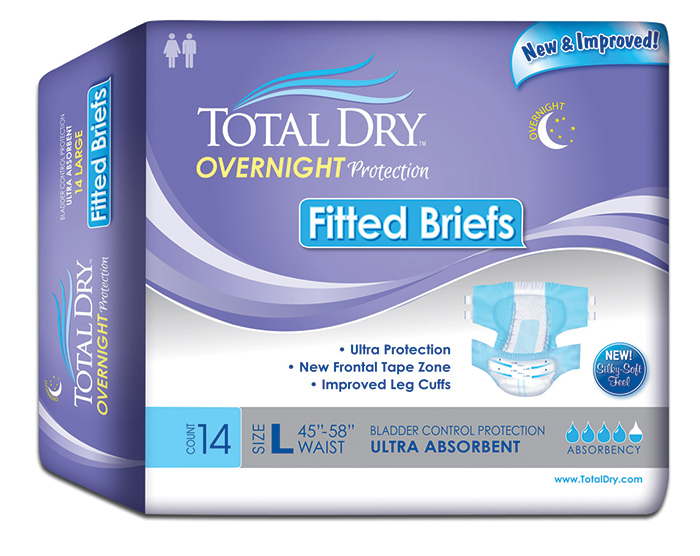 Total Dry products
Total Dry productsTotal Dry by Secure Personal Care Products
Dr. Ara Sayabalian, Clinical Outcomes Specialist
www.securepersonalcare.com
What products does your company provide in the incontinence market?
SAYABALIAN: Total Dry manufactures the entire array of incontinence products focusing on three core attributes and beliefs: create products with high performance and superior comfort at a low cost. Total Dry manufactures: guards that can be used with regular clothing, booster pads that can turn a regular adult brief or pull-up into a super absorbent brief or pull-up, pull-ups, overnight disposable briefs, contoured pads and underpads.
How do you differentiate your products from others in the incontinence category?
SAYABALIAN: Total Dry has a proprietary 3-D nonwoven product that has the softest, silkiest feel. This translates to a comfort that has no equal. Total Dry products focus on keeping the skin dry, to prevent rashes, skin degradation, urinary tract infections (UTIs) and other possible serious complications.
What challenges are you seeing in the market and how have they changed?
SAYABALIAN: I often see very price-sensitive caregivers, or facilities that don’t calculate the higher direct and indirect costs that result from poor performing, low-quality products. For example, hospices would benefit from a higher quality brief because it helps prevent skin irritation, lowers risk of pressure ulcers, and lowers the cost of purchasing creams and changing soiled linens. Caregivers realize that paying a couple of dollars more for a case of briefs saves money.
How can HME providers best strategize the sale of incontinence products?
SAYABALIAN: Working with customers to get them into the correct product builds loyalty. Incontinence products are a recurring sale, and the needs of customers and product usage will change over time.
Where are you seeing opportunities with incontinence products?
SAYABALIAN:This consumer is younger than people stereotypically think. Adults often enter this category in their 50s and sometimes younger. Today’s products must be thinner, less bulky and offer better protection and comfort to fit active lifestyle. Although incontinent women outnumber men, the number of men using incontinence products is increasing. The Total Dry guards keep men comfortable, protected and worry-free.
Terms to know: Give us an example of a new term, new terminology or a recent discovery in your area of expertise.
SAYABALIAN: Active incontinence: Think of an active incontinent 50-years-young woman who likes to exercise, enjoys the outdoors and has spent considerable time and energy in how she looks and feels. She is physically fit and has two children. This individual is mentally and physically very healthy but has the occasional bladder leakage when she sneezes, coughs or exerts herself. This is completely normal.
Nocturia: This is the urge to urinate at night that causes a lot of problems. Often, the urge doesn’t even translate into urination, but the urge is there and very excessive. When the consumer gets up in a rush to use the bathroom, she or he can fall and break a hip or the bedding can be soiled by morning.
Pelvic floor therapy: This specialized area focuses on the pelvic floor muscles. Often weakening or dysfunction of the pelvic floor muscles causes incontinence. Through exercising and treating the pelvic floor muscle, the severity of incontinence can decrease, and the rate of incontinence level increasing can slow down.
How are you responding to the demand for value-based medical products/devices and improving treatment outcomes?
SAYABALIAN: Total Dry has built strong partnerships around the globe, and has sourced high-quality products and raw materials but has kept the prices low and passed those savings onto the consumer. We also invest heavily in research and development, and test our products for maximum absorbency and superior comfort at a low price.
What trends are you seeing?
SAYABALIAN: Thinner is better, and thinner doesn’t mean less absorbent.
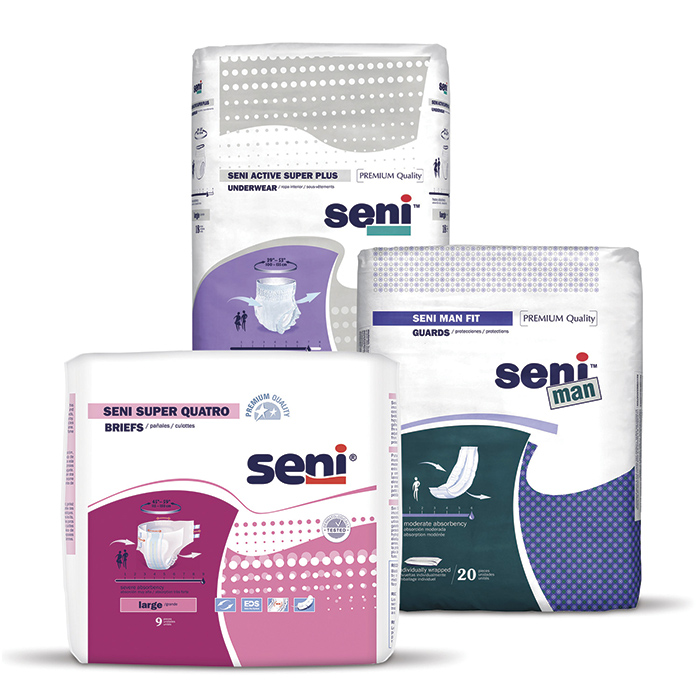 Seni product line
Seni product lineTZMO USA, INC.
Mihaela Grigore, COO
www.seni-usa.com
What products does your company provide in the incontinence market?
GRIGORE: Seni is a full line of premium incontinence products covering needs from very light to severe incontinence. The line includes liners, pads, guards, underwear, briefs, booster pads, shaped pads, underpads and skincare products.
How can HME providers best strategize the sale of incontinence products?
GRIGORE: Find the best selection of quality products, and combine it with educational activities and service. It is important to have a knowledgeable team that can advise on any products they have in the store.
How does your company help HME and other providers?
GRIGORE: We provide free samples for clients to test, to make sure they have the proper size and absorbency; educational materials about incontinence; educational videos about product application; patient transfer and product features; and training for the support team in the store.
What challenges are you seeing in the market, and how have they changed?
GRIGORE: Manufacturers will constantly need to look for new, innovative ways to satisfy a more demanding consumer. In time, this will increase the quality of care and reduce expenses associated with incontinence.
Give us an example of a new term, new terminology or a recent discovery in your area of expertise.
GRIGORE: “Intelligent diapers” or sensors in products that detect when the diaper is ready to be changed.
What trends are you seeing?
GRIGORE: Diversification of product range and better quality, a more patient-oriented approach, optimization by mixing product usage for day and night.
What are the key considerations patients/caregivers should know about incontinence products?
GRIGORE: Proper sizing and absorbency are very important. If a product is well designed and adjusted to the needs of the patient, it doesn’t have to be changed every two hours. Three to four premium products should be sufficient for a 24-hour period. Uninterrupted sleep will improve the overall quality of life of the patient and family. It is important to let the skin breathe to avoid breakdown.
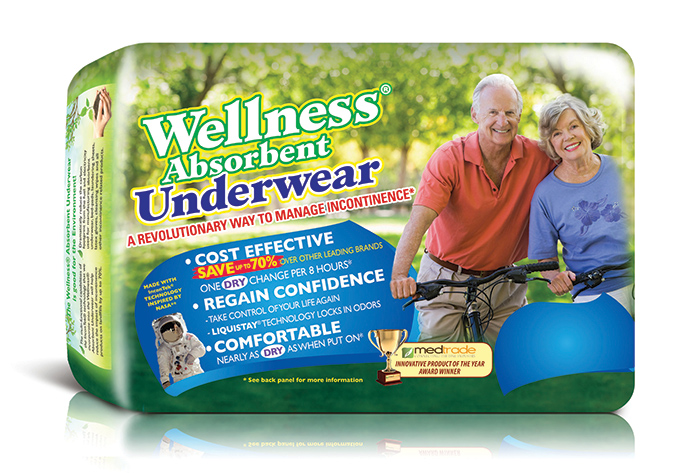 Absorbent Underwear
Absorbent UnderwearUnique Wellness
Steve Goelman, CEO
www.wellnessbriefs.com
What products does your company provide in the incontinence market?
GOELMAN: NASA-inspired incontinence products including absorbent underwear, side tabbed briefs and absorbent underpads.
How do you differentiate your products?
GOELMAN: Our products are designed to absorb in a multi-layered, interlocking core and are marketed for three dry changes in 24 hours.
What challenges are you seeing in the market and how have they changed?
GOELMAN: With Medicaid covering for fewer incontinence products in most states, cash products such as ours have been growing. Many predict that Medicaid will continue in this trend. In addition, baby boomers are not eligible for Medicaid, thus resort to paying out of pocket.
How can HME providers best strategize the sale of incontinence products?
GOELMAN: By focusing on cash consumables and less on reimbursable items, they can use niche incontinence products that can compete with larger stores. Our products save the end user up to 70 percent on incontinence costs over even generic products.
Where are you seeing opportunities?
GOELMAN: Mainly online and in catalogs, but many smart HMEs have realized that they can use our products to compete with larger stores both in value and in performance.
Terms to know: Give us an example of a new term, new terminology or a recent discovery in your area of expertise.
GOELMAN: Cash consumables are what drive repeat customers into stores.
How are you responding to the demand for value-based medical products/devices and improving treatment outcomes?
GOELMAN: Our products reduce exposure to urine thus eliminating all costs associated with dealing with the outcome many have to deal with after maceration to the skin with standard products.
What are the key considerations patients/caregivers should know about incontinence products?
GOELMAN: Although our products are changed only once every eight hours, they are more hygienic than frequent changes with standard products. Unlike standard incontinence products that guarantee exposure to urine on every void and that only changed once that void is discovered, our products wick away all urine from the skin immediately, and lock it in a separate layer so that there is limited exposure from the onset.
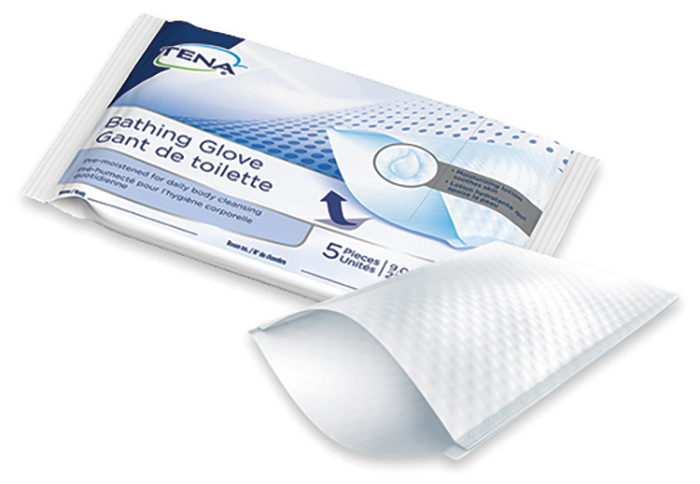 TENA Bathing Glove
TENA Bathing GloveTENA
Teresa Coles, Sales Director, Home Care
www.tenaprofessionals.us
What products does your company provide in the incontinence market?
COLES: TENA develops products that minimize the impact of incontinence and improve the daily lives of people living or working with bladder leakage. Our brand provides a full range of products tailored to the distinct needs of men and women, including pantiliners, daytime and overnight pads, male guards, protective underwear, briefs, skincare products and underpads.
How do you differentiate your products from others in this category?
COLES: We stay close to our customers. We introduced 100 percent breathable briefs and underwear featuring ConfioAir technology, which ultimately helps maintain skin health. We have embraced new, smart technologies. For instance, we developed TENA Identifi for the acute and long-term care sector to enable facilities to track voiding instances, and automatically generate reports on urinary patterns and volumes so they can better determine the most appropriate incontinence products and care to meet specific needs.
What challenges are you seeing in the market and how have they changed?
COLES: States continue to move incontinence users, such as the elderly and disabled, into Managed Care plans, which are focused on access, quality and positive outcomes. Reimbursement rate cuts mean providers and dealers are struggling to maintain revenue flow. Within these Managed Care Organization contracts, the burden falls on them to balance profit with providing a product that performs. They are becoming savvier in their ability to diversify their payer mix to generate positive cash flow.
How does your company help HME and other providers?
COLES: Having the right merchandising solution—planograms, shelf signs and educational materials—is important. We assist providers with engaging shelving and merchandising solutions. We provide a line of products not found in big box retail, but having the nationally recognized TENA brand name on the shelf helps drive repeat customer visits. We also provide a value-tier product line for reimbursement.
Where are you seeing opportunities with incontinence products?
COLES: Online sales of incontinence products can help increase cash flow into their business.
What are the key considerations patients/caregivers should know about incontinence products?
COLES: TENA has products to meet the varying stages of incontinence for individuals whether they are bed bound or mobile. We just launched the new TENA Super Overnight Underwear to address the needs of those with bladder leakage at night.
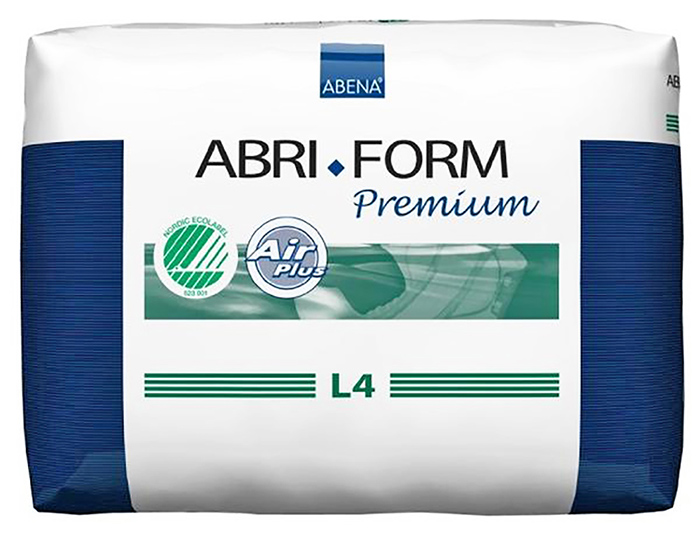 Abri-Form Premium
Abri-Form PremiumAbena
Ken Edmunds, Key Account Manager
www.abena-na.com
What products does your company provide in the incontinence market?
EDMUNDS: Abena is widely considered by most industry experts to be the highest performing, fully breathable incontinence product on the market. The adult line includes tabbed briefs, protective underwear, and a comprehensive line of bladder control pads for men and women on the disposable side, and a full array of washable underpads and chair pads on the reusable side.
How do you differentiate your products from others in the incontinence category?
EDMUNDS: The construction of our product line is more robust than the standard offerings, in terms of sheer absorbency and degree of breathability. We also meet virtually every eco-certification measure relative to this product category.
How can HME providers best strategize the sale of incontinence products?
EDMUNDS: One of the biggest challenges independently owned HMEs face today is competing with chain outlets that source the same products they carry at much lower costs. HME providers will need to choose brands carefully and, where possible, avoid the typical products carried by large companies.
How does your company help HME and other providers face the challenges?
EDMUNDS: Our marketing program, Evolution, helps launch our line at the store level and helps create the demand for this important cash sale. This program includes display units, planograms, store signage, consumer brochures and unlimited samples.
Where are the opportunities with incontinence products?
EDMUNDS: Consumers: The products that address stress incontinence (bladder control pads and protective underwear) will be the leaders.
What trends are you seeing?
EDMUNDS: The prevalence of stress incontinence, the migration back to cash sales, and the consumer’s need to successfully age-in-place are among the top trends we see.
Terms to know: Give us an example of a new term, new terminology or a recent discovery in your area of expertise.
EDMUNDS: As in all industries, new terms come and go relative to the ever-changing parade of features and benefits trotted out for consumer approval. The biggest innovation I’ve seen in the last two decades will be the release of Abena’s new “smart diaper”, Abena Nova.
What are the key considerations patients/caregivers should know about incontinence products?
EDMUNDS: Rather than looking at the price per bag or per unit, seek products that deliver no leakage, no odor and skin protection consistently. Chances are you will find that these are the same products that require less changing, resulting in a comparable or lower overall spend to meet the needs.
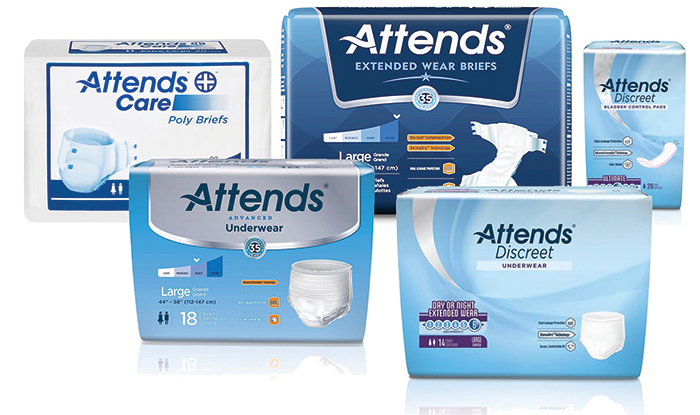 Domtar Attends line of products
Domtar Attends line of productsDomtar Personal Care
Chris Lee, Brand Manager
www.domtar.com
What products does your company provide in the incontinence market?
LEE: We manufacture absorbent hygiene products for all levels and stages of incontinence. Attends has historically been a large player in the healthcare/institutional markets but are expanding into lighter, more retail focused solutions for the active market.
What trends are you seeing?
LEE: Male products: retail, clinical and consumer interest around solutions for men suffering from incontinence.
Fecal incontinence: It's coming to the forefront because it affects millions of people across the U.S. Our Butterfly Body Liner is one of the only products for people with light bowel leakage.
Bed-wetting: People are not necessarily incontinent but looking for solutions for wetting the bed at night. The NAFC is developing a lot of programming around this issue.
Service delivery: Direct to consumer shipments and subscription to home and the overall availability and awareness of incontinence products.
Where are you seeing opportunities with incontinence products?
LEE: Growing cash sales, improved education for HME staff, thinner more absorbent products—changing the perception of thin, unique solutions—fecal incontinence, men’s incontinence.
How are you responding to the demand for value-based medical products/devices?
LEE: We're not only looking at health and wellness outcomes of the patients, but the overall well-being and satisfaction of a caregiver, or financial and operational outcomes of a facility.
How does your company help HME and other providers face these challenges?
LEE: We focus on the needs of HME and independent pharmacies. We have optimized the bag and case configurations to fit a wider variety of products in a smaller space. We have made the decision to only focus on small format retailers and not sell to brick and mortar mass retail, which allows smaller stores to compete.
The development of our Attends Discreet starter kit was a major move to improve how small format retailers break into the incontinence category. We have also included selling and education materials. This allows the stores to get a full range of incontinence products in their stores at a lower cost and less inventory than ordering full cases. They can then optimize their assortment based on how different items sell in their store.
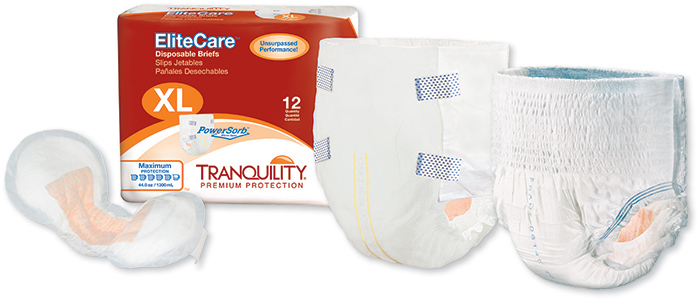 Tranquility product line
Tranquility product linePrinciple Business Enterprises, Inc.
Andrew Stocking, PhD, Executive Vice President, Marketing & Data Analytics
www.tranquilityproducts.com
What products does your company provide in the incontinence market?
STOCKING: The Tranquility family of incontinence products include very high performing (absorbency and leak protection standards) products in the following categories: Disposable absorbent underwear (sometimes called pull-ons); briefs; personal care pads; diaper doublers or booster pads for extra protection; underpads. Professional caregivers describe Tranquility products as the highest performing products on the market place, designed for those with chronic or long term needs “when performance matters most.”
How do you differentiate your products from others in the incontinence category?
STOCKING: Consumers and caregivers tell us that they consistently choose Tranquility when they need absolute protection from leakage, skin breakdown, UTIs and incontinence-related falls. Tranquility products are available in sizes ranging from toddler to bariatric.
What challenges are you seeing in the market and how have they changed?
STOCKING: The biggest challenges relate to the interaction of the online market and the traditional brick and mortar marketplace. We have seen our products sold online by unscrupulous enterprises at very low prices that create customer confusion. Such entities bring little “value-add” to the market and often undermine the value provided by brick and mortar sellers. Manufacturers are limiting the number of dealers who are authorized to market their products online to only those who have complied with very specific market principles.
How can HME providers best strategize the sale of incontinence products?
STOCKING: Successful HME providers often appear to be those that focus on customized service. We offer significant training and business development support to help dealers expand their service scope.
Where are you seeing opportunities with incontinence products?
STOCKING: There are many “underserved populations” who need higher performing INCO products, but don't know they are available or haven't found them. Tranquility products fit that description. Bringing focus to the HME dealers business plan through the targeting of specific disease states or other underserved populations is a strength of PBE and we welcome the opportunity to assist with the development of any firm’s annual growth plan and training.
How are you responding to the demand for value-based medical products/devices?
STOCKING: That is the sweet spot of the Tranquility product line because it is widely recognized for improving clinical outcomes, improving the quality of life for consumers and caregivers and also providing the highest value proposition. We see an increasing emphasis on managing the total cost of care, which includes costs associated with slips, falls, incontinence-related wounds, UTIs and laundry. Leakage and skin wetness are huge concerns because they are real cost drivers and misery-drivers for both the caregiver and the care-recipient. They lead to a great deal of avoidable costs from excessive linen changes, staff burnout and costly physical complications and user-experience degradation.




